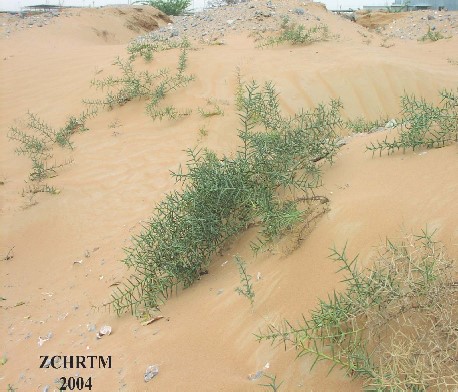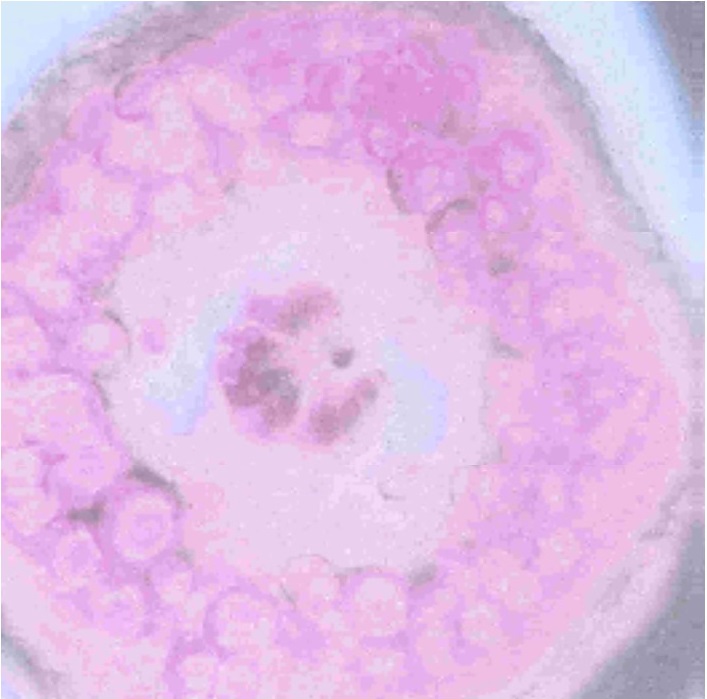
Alhagi maurorum / اﻟﻌﺎﻗﻮل
Alhagi maurorum medik
Al-Agool, Shouk Aljemal, Hai, Agool, Shabram, Al lahlah, Shouk, Aljam
Camel thorn
Al-Agool, Shouk Aljemal, Shwaika
Fabaceae

Plant Habitat

Plant Habitat

Herbarium Sample
Ethnobotanical Characteristics
Description
A shrubby evergreen perennial herb, woody base, erect to ascending up to 60(-100) cm high, very much branched with rigid spiny twigs about 1 in. long. Leaves deciduous simple, small, present at base of each side twig, obovate to oblong, shortly petiolate, with rounded tip, up to 2 cm. Flowers solitary or in pairs in axils and along twigs, with deep red to purple papillionate petals. Fruit a cylindrical pod, 1-3 cm, fairly thick straight , dark brown with constrictions between seeds; seeds 3-8 kidney shaped, smooth and brown.
Habitat & Distribution
It is a plant of tropical and subtropical regions, found in Africa, Asia, US, Europe and Middle East. Common in disturbed Urban sites, abundant along riverbanks, canals, irrigation ditches and sometimes in cultivated field. Common along Arabian Gulf Coast; less frequent inland.
Part(s) Used
Aerial parts
Traditional and Medicinal Uses
The plant is well known in India, Iran and Arabia. In U.A.E the plant is used as a general tonic, anthelmintic and to treat constipation, jaundice, arthritis, roots are used as aphrodisiac and it is a good fodder for camels. In other countries the plant is known to be diuretic, blood purifier, with antimicrobial activity, used for dysentery, upper respiratory system problems, wounds, hemorrhoids & uterus problems.
Pharmacognosy and Phytochemistry
Parts studied
Leaves & branches
Microscopical Description
Leaves:
Both upper and lower epidermises are covered by thick cuticle. Epidermal cells of both surfaces are polygonal, periclincal of various sizes and shapes with straight to slightly wavy cell walls. Stomata in both surfaces are oval and of the anomocytic type. Upper epidermis is underlined by a single layer of hypodermis. The mesophyll is differentiated almost exclusively into elongated compact palisade parenchyma indicating the xeromorphic feature of the plant. The vessels of the embedded vascular tissues are annularly and spirally thickened.
Branches:
Transverse section of a young branch is circular in outline and its epidermis is also covered by a thick cuticle. The epidermal parenchyma cells are comparatively larger than those of leaf and the scattered stomata are also larger. Cortex comprises few layers of parenchyma cells. Phloem consists of compact tissues of lignified sieve tubes with parenchyma and companion cells. Tissues are frequently tranversed by medullary rays. The xylem consists of a wide continuous ring of lignified tissues composed of vessels, tracheids, fibers, xylem parenchyma and medullary rays. Vessels are annularly and spirally thickened. Pith consists of oval and rounded thick-walled parenchyma cells (Kamil et al.2001)

a) Upper epidermis

b) T S of leaf

c) T S of petiole
a) Surface view of the upper epidermis showing its polygonal cells and underlying three large oblong hypodermal cells; oval stomata are also shown.
b) TS of leaf showing a layer of small rectangular upper epidermal cells underlain by large oblong cells of the hypodermis followed by relatively smaller palisade cells.
c) TS of a leaf petiole showing the heavily lignified vascular tissues. (Magnifications x400 x 400 and x 100, respectively).
Organoleptic characteristics
Appearance: Powder
Colour: Yellowish green
Odour: Aromatic
Taste: Acrid
Physicochemical constants
Loss in weight on drying at 105°C (%): 9.2-9.5
Solubilities(%)
Alcohol solubility: 14.00 – 15.00
Water solubility: 23.00 – 24.00
10% ethanolic extractive: 34.00 – 35.50
Ash values (%)
Total ash: 11.20 – 11.40
Water soluble ash: 6.4 – 6.6
Acid-insoluble: Nil
Successive extractive (%)
Petroleum ether (60-80°): 4.6 – 6.8
Chloroform: 1.00 – 1.10%
Absolute alcohol: 8.1 – 8.2
Distilled water: 26.8 – 27.00
pH values
pH of 1%: 5.73
pH of 10%: 5.42
Chemical constituents
Alkaloids, flavonoids, glycosides, steroids, terpenoids, resins and tannins are found in different extracts. Quantitative analyses of important inorganic elements have been performed in ash. (Kamil, et.al 2000; 2001).
Pharmacological and Toxicological studies
Both the ethanolic and chloroform extracts produced CNS stimulation in mice. Slight tremors, straub tail, rapid respiration, twitches, excitability and slight itching were recorded (Al-Yahya et. al., l985a). The extract caused an increased force of contraction of isolated rabbit heart and slight fall in blood pressure of anaesthetized rabbit (Al-Yahaha et. al., l985b) .The flavonoid fraction of the plant is reported to possess anti-inflammatory activity. The extract showed no significant effect on the level of serum glucose, cholesterol and potassium in rats. However, chloroform extract caused a decrease in serum sodium content. The extracts showed antimicrobial activity and are not toxic to Brine shrimps (Al-Yahaya et. al., l985 b).
The pharmacological and toxicological studies carried out in our laboratory and the results in brief, on Alhagi maurorum (10% ethanolic extract) have been given below. The results presented without references showed unpublished data (unpublished results, ZCHRTM, DBMS)
1. 10% Ethanolic Extract
| ACTIVITY | RESULTS |
| Anti-inflammatory activity-Rat paw oedema | Extract showed significant antiinflammatory activity in acute model (Zakaria et al., 1999). |
| Anti-inflammatory activity-Cotton pellet | Extract showed significant antiinflammatory activity in sub-acute model (Zakariaet al., 1999). |
| Antinociceptive activity-Tail flick | Extract showed antinociceptive activity. |
| Antinociceptive activity-Writhing | Extract showed antinociceptive activity. |
| Gastric ulcer activity- Indomethacin | Extract produced gastroprotective activity (Islam et. al., 200 a; Islam et. al., 200 b). |
| Gastric ulcer activity- Phenylbutazone | Extract produced gastroprotective activity (Islam et. al., 200 a; (Islam et. al., 200 b). |
| Gastric ulcer activity-NaOH | Extract produced cytoprotective activity (Islam et. al., 200 a; Islam et. al., 200 b). |
| Gastric ulcer activity-Ethanol | Extract did not show cytoprotective activity (Islam et. al., 200 a; Islam et. al., 200 b). |
| Sexual studies-Copulatory activity | Extract Extract showed significant sexual stimulant activity. |
| Sexual studies-ICP | Extract increased intracavernous pressure. |
| Testosterone quantification | Increased testosterone level in treated animals. |
| Anti-hypertension activity- Anesthetic rats | Extract produced a transient increase in diastolic blood pressure, normalized after 30 min. Increased heart rate. |
| Locomotor activity | Significant increase in locomotor activity was observed (Islam et al., 2000c). |
| Gross behavioral studies-Tremor/Twitches | No toxic effect observed (Islam et al., 2000c). |
| Gross behavioral studies-Writhing | No toxic effect observed (Islam et al., 2000c). |
| Gross behavioral studies- Diarrhea, Urination | Produced no diarrhea and urination (Islam et al., 2000c). |
| Mortality | No mortality recorded (Islam et al., 2000). |
| Motor co-ordination (String and Platform test) | Motor coordination not affected (Islam et al., 2000c). |
| Acute toxicity studies- | No toxic symptoms observed at the dose tested (Islam et al., 2000c). |
| LD50 evaluation | > 10 g/kg (Islam et al., 2000c). |
| Sub-acute toxicity studies | No significant symptomatic changes were observed (Islam et al., 2000c). |
| Sub-chronic toxicity studies | Extract did not show any significant changes in body weight, vital organs studied (Islam et al., 2000c). |
| Hematological studies | No changes in hematological parameters (Islam et al., 2000c). |
| Biochemical studies | No changes in biochemical parameters except slight increase in plasma calcium and phosphorus (Islam et al., 2000c). |
| Effect on body weight | No changes observed (Islam et al., 2000c). |
| Effect on vital organ weight | No changes observed (Islam et al., 2000c). |
| Teratogenicity | Extract did not show teratogenic effect; No foetotoxicity and maternal toxicity observed (Islam et al., 2000c). |
| Mutagenicity | Extract did not show mutagenic (Clastogenic) activity as evidenced by micronuclei test (Islam et al., 2000c). |
Summary of the results
Alhagi maurorum (10% ethanolic extract) showed significant antiinflammatory, analgesic, gastroprotective and sexual activity. The 10% ethanolic extract did not show serious toxic changes at the dose tested. No teratogenic and mutagenic effects were observed.
2. Aqueous Extract :
| ACTIVITY | RESULTS |
| Sexual studies-Copulatory activity | Extract showed sexual stimulant activity. |
| Vasorelaxant activity-Isolated aortic strip | Extract produced relaxation in the contracted aortic strip. |
| Cardiotonic activity & HR-Isolated rat atria | Did not show any significant change. |
| Effect on GIT smooth Muscle-Isolated guinea pig ileum | Did not show any significant change in isolated Guinea pig ileum. |
| Effect on GIT smooth Muscle-Isolated rat fundus | Produced contraction. |
| Gross behavioral studies-Tremor/Twitches | No toxic symptoms observed. |
| Gross behavioral studies-Writhing | No toxic symptoms observed. |
| Gross behavioral studies-Diarrhea, Urination | No diarrhea and urination observed. |
| Mortality | No death recorded. |
Summary of the results
Alhagi maurorum (Aqueous ethanolic extract) showed significant sexual stimulant activity and showed no overt toxic signs and symptoms at the dose tested.
References
- Al-Yahaya, M.A., Moussa, J.S., Al-Meshal, I.A. , Al-Badar, A.A., and Tariq, M., (l985a) Phytochemical and pharmacological studies for the treatment of fever, 4th South Asian /Western Pacific regional Meeting of Pharmacologists. Penang, Malaysia.
- Al-Yahaya, M.A., Moussa, J.S., Tariq, M., Al-Meshal, I.A. and Al-Badar, A.A. (l985b) Phytochemical and pharmacological studies on Saudi plants of family Leguminosae, 4th South Asian /Western Pacific Regional Meeting of Pharmacologists. Penang, Malaysia
- Andrews, F.W. The Flowering Plants of Anglo-Egyptian Sudan; (1950&1952) vol 1+II; Arbroath, Scotland.
- Department of Biomedical Sciences, Zyed Complex for Herbal Research and Traditional Medicine, Unpublished results.
- El-Ghonemy, A. A. Encyclopedia of Medicinal Plants of the United Emirates. (1993)1st Edition, University of U.A.E.
- Islam, M.W. Zakaria, M.N.M. Radhkrishnan, R.. Chan K ,and Al-Attas. A. Effect Of Alhagi maurorum Medilc. (Leguminoseae) on Acute Gastric Lesions in Rats. 1st International Congress on Traditional Medicine & Materia Medica, Tehran 2000.
- Jongbloed, M.V. The Comprehensive Guide to the Wild Flowers of the united Arab Emirates, Erwda, (2003) Emirates Printing Press, Dubai, U.A.E.
- Kamil M, Ahmad F, Jairaj A F , Gunasekar C, Thomas S, Chen K & Attas A. Pharmacognostic and Phytochemical studies on aerial parts of Alhagi maurorum Medik . Hamdard Medicus ,2001 ,.XL1V ,No. 3: 57-71.
- Kamil M, Ahmad F, Jairaj A F , Gunasekar C, Thomas S, Chen K & Attas A. Quality control Protocols for Alhagi maurorum 48th Annual Meeting of soc. For medicinal Plants Res. Natural Product Research in New Millenium, Sep,2000 , Zurich, Switzerland:4-A/13.
- Kotb, T. F. Medicinal Plants in Libya .Arab Encyclopedia House. (1985) Tripoli-Libya.
- Mandaville,J.P. Flora of Eastern Saudi Arabia. (1990) Kegan Paul International Ltd. England.
- Western, A. R. The Flora of United Arab Emirates, an introduction. (1986) Publication of the U.A.E University.
- Zakaria, M.N.M., M.W. Islam, R. Radhakrishnan, H.B. Chen, A. Ismail, K. Chan and M. Habibullah. Pharmacological evaluation of antiinflammatory activity of Alhagi maurorum. J Pharm Pharmacol. 1999, 51 (Suppl): 118.
- محمد العودات، جورج لحام النباتات الطبیة واستعمالاتھا،( 1988 ) الجزء الأول- الطبعة الثانیة.الأھالي، سوریا
- ھانئ عرموش الأعشاب في كتاب: الاستخدامات الطبیة- العلاجیة- التجمیلیة- التصنیعیة. ( 1999 ) دار النفائس، دمشق، سوریا
